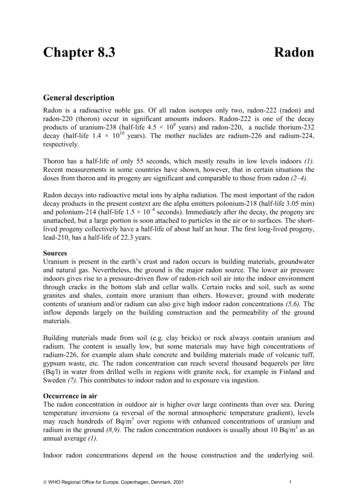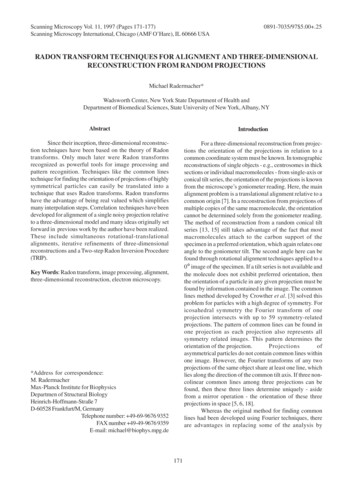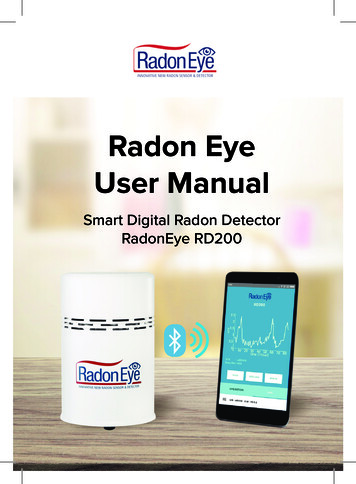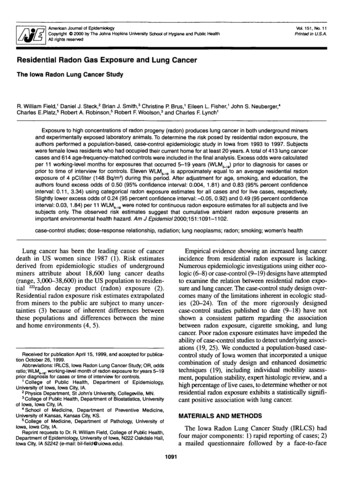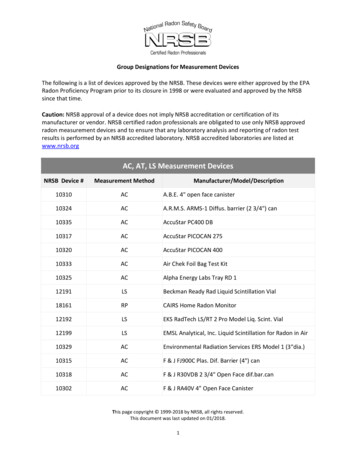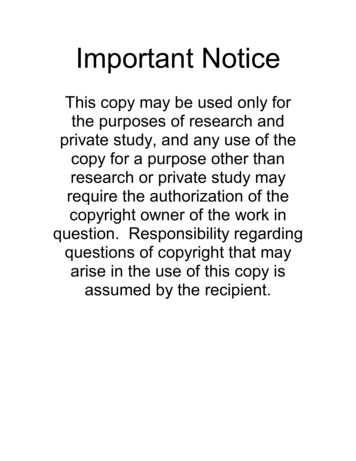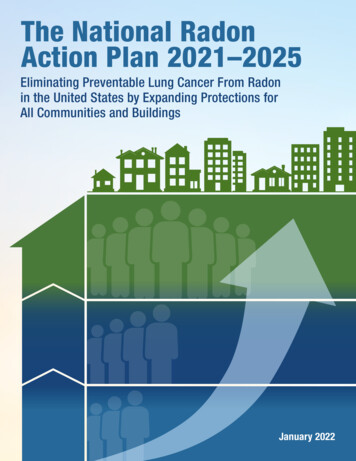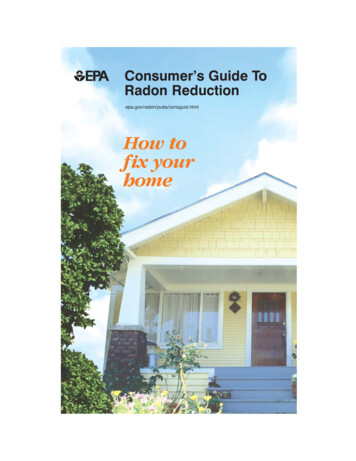
Transcription
Consumer’s Guide ToRadon Reductionepa.gov/radon/pubs/consguid.htmlHow tofix yourhome
A Consumer’s Guide to Radon ReductionConsumer’sOVERVIEWReduce Radon Levels In Your HomeRadon is the second leading cause of lung cancer. The Surgeon Generaland the EPA recommend testing for radon and reducing radon in homesthat have high levels. Fix your home if your radon level is confirmed to be4 picocuries per liter (pCi/L) or higher. Radon levels less than 4 pCi/Lstill pose a risk, and in many cases may be reduced. If you smoke and yourhome has high radon levels, your risk of lung cancer is especially high.Select A State Certified and/or QualifiedRadon Mitigation ContractorChoose a qualified radon mitigation contractor to fix your home. Start bychecking with your state radon office (see p. 17). Many states requireradon professionals to be licensed, certified, or registered. You can alsocontact private radon proficiency programs for lists of privately certifiedradon professionals in your area. See page 4 for more information.Radon Reduction Techniques WorkRadon reduction systems work. Some radon reduction systems can reduceradon levels in your home by up to 99%. The cost of fixing a homegenerally ranges from 800 to 2500 (with an average cost of 1200).Your costs may vary depending on the size and design of your home andwhich radon reduction methods are needed. Hundreds of thousands ofpeople have reduced radon levels in their homes.Maintain Your Radon Reduction SystemMaintaining your radon reduction system takes little effort and keeps thesystem working properly and radon levels low (see p. 13).U.S. EPA, 402-K-06-094, Revised December 2006
A Consumer’s Guide to Radon ReductionConsumer’sINTRODUCTIONYou have tested your home for radon, but now what? This booklet is forpeople who have tested their home for radon and confirmed that they haveelevated radon levels — 4 picocuries per liter (pCi/L) or higher.This booklet can help you: Select a qualified radon mitigation contractor to reduce the radon levelsin your home Determine an appropriate radon reduction method Maintain your radon reduction systemIf you want information on how to test your home for radon, call your state radonoffice (see p. 17) and ask for a copy of either A Citizen's Guide to Radon or, iftesting during a home sale, the Home Buyer’s and Seller’s Guide to Radon. On-lineversions of both documents are also available at http://www.epa.gov/radon/pubs.U.S. EPA, 402-K-06-094 Revised December 20061
A Consumer’s Guide to Radon ReductionConsumer’sHOW RADON ENTERS YOUR HOUSERadon is a naturally occurring radioactivegas produced by the breakdown ofuranium in soil, rock, and water.Air pressure inside your home is usually lowerthan pressure in the soil around your home'sfoundation. Because of this difference inpressure, your house acts like a vacuum,drawing radon in through foundation cracksand other openings. Radon may also bepresent in well water and can be released intothe air in your home when water is used forshowering and other household uses. In mostcases, radon entering the home through wateris a small risk compared with radon enteringyour home from the soil. In a small numberof homes, the building materials (e.g., graniteand certain concrete products) can give offradon, although building materials rarely causeradon problems by themselves. In the United States, radon gas in soil is theprincipal source of elevated radon levels in homes.RADON IS A CANCER-CAUSING,RADIOACTIVE GASRadon is estimated to cause many thousands of lung cancer deaths each year.In fact, the Surgeon General has warned that radon is the second leadingcause of lung cancer in the United SStates.tates. Only smoking causes more lungUnitedcancer deaths. If you smoke and your home has high radon levels, your risk oflung cancer is especially high.WHAT DO YOUR RADON TEST RESULTS MEAN?Any radon exposurwer theexposuree has some risk of causing lung cancercancer. The lolowradon level in yyourour home, the lower yyourour family's risk of lung cancerlevellowcancer.The amount of radon in the air is measured in "picocuries of radon per literof air," or "pCi/L." Sometimes test results are expressed in Working Levels,"WL,"rather than picocuries per liter of air. A level of 0.016 WL is usually equal toabout 4 pCi/L in a typical home.2U.S. EPA, 402-K-06-094, Revised December 2006
A Consumer’s Guide to Radon ReductionConsumer’sThe U.S. Congress has set a long-termgoal that indoor radon levels be no morethan outdoor levels; about 0.4 pCi/L ofradon is normally found in the outsideair. EPA recommends fixing your homeif the results of one long-term test or theaverage of two short-term tests showradon levels of 4 pCi/L (or 0.016 WL)or higher. With today's technology,radon levels in most homes can bereduced to 2 pCi/L or below. Youmay also wantto consider fixing if the level is between2 and 4 pCi/L.A short-term test remains in your homefor 2 days to 90 days, whereas a long-termtest remains in your home for more than90 days. All radon tests should be takenfor a minimum of 48 hours. A shortterm test will yield faster results, but along-term test will give a betterunderstanding of your home’s yearround average radon level.The EPA recommends two categoriesof radon testing. One category is forconcerned homeowners or occupantswhose house is not for sale; refer toEPA’s pamphlet A Citizen’s Guide toRadon for testing guidance. The secondcategory is for real estate transactions;refer to EPA’s pamphlet Home Buyer’sand Seller’s Guide to Radon, whichprovides guidance and answers to somecommon questions.U.S. EPA, 402-K-06-094 Revised December 2006SELECTING A RADONTEST KITSince you cannot see or smell radon,special equipment is needed to detectit. When you’re ready to test yourhome, contact your state radon office(see p. 17) for information on locatingqualified test kits or qualified radontesters. You can also order test kitsand obtain information from a radonhotline (see p. 17). There are two typesof radon testing devices. Passiveradon testing devices do not needpower to function. These includecharcoal canisters, alpha-trackdetectors, charcoal liquid scintillationdevices, and electret ion chamberdetectors. Both short- and long-termpassive devices are generallyinexpensive. Active radon testingdevices require power to function andusually provide hourly readings and anaverage result for the test period.These include continuous radonmonitors and continuous workinglevel monitors, and these tests maycost more. A state or local official canexplain the differences betweendevices and recommend ones whichare most appropriate for your needsand expected testing conditions.Make sure to use a radon testingdevice from a qualified laboratory.3
A Consumer’s Guide to Radon ReductionConsumer’sWHY HIRE A CONTRACTOR?EPA recommends that you have a qualified radon mitigation contractor fix yourhome because lowering high radon levels requires specific technical knowledgeand special skills. Without the proper equipment or technical knowledge,you could actually increase your radon level or create other potential hazards andadditional costs. However, if you decide to do the work yourself, get informationon appropriate training courses and copies of EPA's technical guidance documentsfrom your state radon office.WILL ANY CONTRACTOR DO?Etified and/or qualified radonPA recommends that you use a state cercertifiedmitigation contractor trained to fix radon problems. You can determine aservice provider’s qualifications to perform radon measurements or to mitigateyour home in several ways. First, check with your state radon office (see p. 17).Many states require radon professionals to be licensed, certified, or registered, andto install radon mitigation systems that meet state requirements. Most states canprovide you with a list of knowledgeable radon service providers doing business inthe state. In states that don’t regulate radon services, ask the contractor if they holda professional proficiency or certification credential, and if they follow industryconsensus standards such as the American Society for Testing and Materials(ASTM) Standard Practice for Installing Radon Mitigation Systems in ExistingLow-Rise Residential Buildings, E2121 (February 2003). You can contact privateproficiency programs for lists of privately-certified professionals in your area.Such programs usually provide members with a photo-ID card, which indicatestheir qualification(s) and the ID-card’s expiration date. For more information onprivate proficiency programs, visit www.epa.gov/radon/proficiency.html, or contactyour state radon office.HOW TO SELECT A CONTRACTORGet EstimatesChoose a contractor to fix a radon problem just as you would choose someoneto do other home repairs. It is wise to get more than one estimate, to ask forreferences, and to contact some of those references to ask if they are satisfied withthe contractors' work. Also, ask your state radon office or your county/stateconsumer protection office for information about the contractors.4U.S. EPA, 402-K-06-094, Revised December 2006
A Consumer’s Guide to Radon ReductionConsumer’sUse this checklist when evaluating and comparing contractors and ask thefollowing questions:YES NOW ill the contractor provide rrefereferences or photographs, as well as test rresultsesults ofproeferenceswelle' and 'after' radon levels of past radon rreductioneduction work?'before'levelswork?'beforCan the contractor explain what the work will involve, how long it will take toworkinvolvolve,howw the radon rreductioneduction system will work?complete, and exactly hohowwork?Does the contractor charge a fee for any diagnostic tests? Although manycontractors givee estimates, they may charge for diagnostic tests. These testsgivee frfreehelp determine what type of radon rreductioneduction system should be used and in somecases araree necessarnecessaryy, especially if the contractor is unfamiliar with the type of housestructuree of difficultyee "Radon Reductionucturee or the anticipated degrdegreedifficulty. SSeeReductionstructurTechniques" (p(p. 8) for mormoree on diagnostic tests.Did the contractor inspect yyourour home's structurou an estimate?structuructuree beforbeforee giving yyouDid the contractor rrevieeview the quality of yyourour radon measurement rresultsesults andeviewmeasurementdetermine if appropriate testing procedures werwed?procedurocedureswereree follofollowappropriateCompare the contractor's proposed costs and consider what you get for yourmoney, taking into account: (1) a less expensive system may cost more to operateand maintain; (2) a less expensive system may have less aesthetic appeal; (3) a moreexpensive system may be best for your house; and, (4) the quality of the buildingmaterial will affect how long the system lasts.Do the contractors' proposals and estimates include:YES NOProof of state certification and/or professional proficiency or ertificationcredentials?credentials?Proof of liability insurance and being bonded, and having all necessarnecessaryy licenses toements?satisfy local rrequirequirequirements?Diagnostic testing prior to design and installation of a radon rreductioneduction system?Installation of a warning device to caution yyouou if the radon rreductioneduction system is notectly?working corrworkingcorrectly?Testing after installation to make sureduction system works well?suree the radon rreductionworkswell?A guarantee to rreduceeduce radon levels to 4 pCi/L or below, and if so, for how long?levelsbelowhowU.S. EPA, 402-K-06-094 Revised December 20065
A Consumer’s Guide to Radon ReductionConsumer’sThe ContractAsk the contractor to prepare a contract before any work starts. Carefully readthe contract before you sign it. Make sure everything in the contract matches theoriginal proposal. The contract should describe exactly what work will be doneprior to and during the installationof the system, what the system consistsof, and how the system will operate.Many contractors provide a guaranteethat they will adjust or modify thesystem to reach a negotiated radonlevel. Carefully read the conditionsof the contract describing theguarantee. Carefully consideroptional additions to your contractwhich may add to the initial cost ofthe system, but may be worth theextra expense. Typical options might include an extended warranty, a service plan,and/or improved aesthetics.Important information that should appear in the contract includes:The total cost of the jobes and permit fees; how much,job,, including all taxtaxeshowequired for a deposit; and when payment is due in full.any,, is rrequirequiredif anyThe time needed to complete the work.work.An agreement bbyy the contractor to obtain necessarwagreementnecessaryy permits and follofollowrequired building codes.equiredA statement that the contractor carries liability insurance and is bondedand insured to protect yyouou in case of injurinsuredprotectinjuryy to persons, or damage topropertyk is being done.properopertyty,, while the worworkA guarantee that the contractor will be rresponsibleesponsible for damage during thejob and clean-up after the job.Details of any guarantee to rreduceeduce radon below a negotiated level.belowlevel.Details of warranties or other optional features associated with thefeatureshardwarhardwardwaree components of the mitigation system.A declaration stating whether any warranties or guarantees araree transferableour home.if yyouou sell yyourA description of what the contractor expects the homeowner to dohomeowner(e.g., make the work area accessible) befork begins.workareabeforee worwork6U.S. EPA, 402-K-06-094, Revised December 2006
A Consumer’s Guide to Radon ReductionConsumer’sWHAT TO LOOK FOR IN A RADONREDUCTION SYSTEMIn selecting a radon reduction method for your home, you and your contractorshould consider several things, including: how high your initial radon level is,the costs of installation and system operation, your house size, and yourfoundation type.Installation andOperating CostsThe cost of a contractor fixing a homegenerally ranges from 800 to 2500,depending on the characteristics of thehouse and choice of radon reductionmethods. The average cost of a radonreduction system is about 1200.Most types of radon reductionsystems cause some loss of heated orair conditioned air, which couldincrease your utility bills. How muchyour utility bills increase will depend on the climate you live in, what kind ofreduction system you select, and how your house is built. Systems that use fans aremore effective in reducing radon levels; however, they will slightly increase yourelectric bill. The table on page 16 lists the installation and average operating costsfor different radon reduction systems and describes the best use of each method.U.S. EPA, 402-K-06-094 Revised December 20067
A Consumer’s Guide to Radon ReductionConsumer’sRADON REDUCTION TECHNIQUESThere are several methods that a contractorcan use to lower radon levels in yourhome. Some techniques prevent radonfrom entering your home while others reduceradon levels after it has entered. EPA generallyrecommends methods which prevent the entryof radon. S oil suctionsuction, for example, preventsradon from entering your home by drawingthe radon from below the house and venting itthrough a pipe, or pipes, to the air above thehouse where it is quickly diluted.Any information that you may have aboutthe construction of your house could helpyour contractor choose the best system.Your contractor will perform a visual inspection of your house and design a systemthat considers specific features of your house. If this inspection fails to provideenough information, the contractor may need to perform diagnostic tests duringthe initial phase of the installation to help develop the best radon reduction systemfor your home. For instance, your contractor can use chemical smoke to find thesource and direction of air movement. A contractor can learn air flow sources anddirections by watching a small amount of smoke that he or she shot into holes,drains, sumps, or along cracks. The sources of air flow show possible radon routes.A contractor may have concerns about backdrafting of combustion appliances whenconsidering radon mitigation options, and may recommend that the homeownerhave the appliance(s) checked by a qualified inspector.Another type of diagnostic test is a "soil communication test." This test uses avacuum cleaner and chemical smoke to determine how easily air can move from onepoint to another under the foundation. By inserting a vacuum cleaner hose in onesmall hole and using chemical smoke in a second small hole, a contractor can see ifthe smoke is pulled down into the second hole by the force of the vacuum cleaner'ssuction. Watching the smoke during a soil communication test helps a contractordecide if certain radon reduction systems would work well in your house.Whether diagnostic tests are needed is decided by details specific to your house,such as the foundation design, what kind of material is under your house, and bythe contractor's experience with similar houses and similar radon test results.8U.S. EPA, 402-K-06-094, Revised December 2006
A Consumer’s Guide to Radon ReductionConsumer’sHouse Foundation TypesYour house type will affect the kind of radon reduction system that will work best.Houses are generally categorized according to their foundation design. For example:basementbasement, slab-on-grade (concrete poured at ground level), or crawlspace(a shallow unfinished space under the first floor). Some houses have more thanone foundation design feature. For instance, it is common to have a basementunder part of the house and to have a slab-on-grade or crawlspace under the restof the house. In these situations a combination of radon reduction techniques maybe needed to reduce radon levels to below 4 pCi/L.Radon reduction systems can be grouped by house foundation design. Find yourtype of foundation design above and read about which radon reduction systemsmay be best for your house.Basement and Slab-on-Grade HousesIn houses that have a basement or a slab-on-grade foundation, radon is usuallyreduced by one of four types of soil suction: subslab suctionsuction, drain tile suctionsuction,sump hole suctionsuction, or block wall suctionsuction.A ctivctivee subslab suction (also called n) is the most common andusually the most reliable radon reductionmethod. One or more suction pipes areinserted through the floor slab into thecrushed rock or soil underneath. They alsomay be inserted below the concrete slabfrom outside the house. The number andlocation of suction pipes that are neededdepends on how easily air can move inthe crushed rock or soil under the slab,and on the strength of the radon source.Often, only a single suction point is needed.U.S. EPA, 402-K-06-094 Revised December 20069
A Consumer’s Guide to Radon ReductionConsumer’sA contractor usually gets this information from visual inspection, from diagnostictests, and/or from experience. A radon vent fan connected to the suction pipe(s)draws the radon gas from below the house and releases it into the outdoor airwhile simultaneously creating a negative pressure (vacuum) beneath the slab.Common fan locations include unconditioned house and garage spaces, includingattics, and the exterior of the house.Passive subslab suction is the same as active subslab suction except it relies on naturalpressure differentials and air currents instead of a fan to draw radon up from belowthe house. Passive subslab suction is usually associated with radon-resistant featuresinstalled in newly constructed homes (see p. 14). Passivassivee subslab suction is generallynot as effective in reducing high radon levels as active subslab suction.forated pipe to direct water away from theSome houses have drain tiles or perperforatedfoundation of the house. Suction on these tiles or pipes is often effective inreducing radon levels.One variation of subslab and drain tile suction is sump hole suctionsuction. Often, whena house with a basement has a sump pump to remove unwanted water, the sumpcan be capped so that it can continue to drain water and serve as the location for aradon suction pipe.Block wall suction can be used in basement houses with hollow block foundationwalls. This method removes radon and depressurizes the block wall, similar tosubslab suction. This method is often used in combination with subslab suction.Crawlspace HousesAn effective method to reduce radon levels in crawlspace houses involves coveringthe earth floor with a high-density plastic sheet. A vent pipe and fan are used todraw the radon from under the sheet and vent it to the outdoors. This form of soiloperly applied is the mostsuction is called submembrane suction, and when prproperlyeffectiveduce radon levels in crawlspace houses. Another less-favorableeffectivee way to rreducelevelsoption is active crawlspace depressurization which involves drawing air directlyfrom the crawlspace using a fan. This technique generally does not work as well assubmembrane suction and requires special attention to combustion appliancebackdrafting and sealing the crawlspace from other portions of the house, and mayalso result in increased energy costs due to loss of conditioned air from the house.In some cases, radon levels can be lowered by ventilating the crawlspace passively(without the use of a fan) or actively (with the use of a fan). Crawlspace ventilationmay lower indoor radon levels both by reducing the home's suction on the soil and bydiluting the radon beneath the house. Passive ventilation in a crawlspace is achieved10U.S. EPA, 402-K-06-094, Revised December 2006
A Consumer’s Guide to Radon ReductionConsumer’sby opening vents, or installing additional vents. Active ventilation uses a fan to blowair through the crawlspace instead of relying on natural air circulation. In colderclimates, for either passive or active crawlspace ventilation, water pipes, sewerlines and appliances in the crawlspace may need to be insulated against the cold.These ventilation options could result in increased energy costs for the house.Other Types of Radon Reduction MethodsOther radon reduction techniques that can be used in any type of houseinclude: sealing, house/room pressurization, heat recovery ventilation, andnatural ventilation.S ealing cracks and other openings in the foundation is a basic part of mostapproaches to radon reduction. Sealing the cracks limits the flow of radon intoyour home thereby making other radon reduction techniques more effective andcost-efficient. It also reduces the loss of conditioned air. EPA does not recommendthe use of sealing alone to reduce radon because, by itself, sealing has not been shownto lower radon levels significantly or consistently. It is difficult to identify andpermanently seal the places where radon is entering. Normal settling of yourhouse opens new entry routes and reopens old ones.oom pressurization uses a fan to blow air into the basement or living areaHouse/rouse/roompressurizationfrom either upstairs or outdoors. It attempts to create enough pressure at the lowestlevel indoors (in a basement for example) to prevent radon from entering into thehouse. The effectiveness of this technique is limited by house construction,climate, other appliances in the house, and occupant lifestyle. In order to maintainenough pressure to keep radon out, the doors and windows at the lowest level mustnot be left opened, except for normal entry and exit. This approach generallyresults in more outdoor air being introduced into the home, which can causemoisture intrusion and energy penalties. Consequently, this technique should only beconsidered after the other, more-common techniques have not sufficiently reduced radon.ecoentilator (HRHRV ), also called an air-to-air heat exchangerA heat rrecoecovvereryy vventilatorHRVexchangerchanger, can beinstalled to increase ventilation which will help reduce the radon levels in your home.An HRV will increase ventilation by introducing outdoor air while using the heatedor cooled air being exhausted to warm or cool the incoming air. HRVs can bedesigned to ventilate all or part of your home, although they are more effective inreducing radon levels when used to ventilate only the basement. If properly balancedand maintained, they ensure a constant degree of ventilation throughout the year.HRVs also can improve air quality in houses that have other indoor pollutants.There could be significant increase in the heating and cooling costs with an HRV,but not as great as ventilation without heat recovery (see p.16).U.S. EPA, 402-K-06-094 Revised December 200611
A Consumer’s Guide to Radon ReductionConsumer’sentilation occurs in all houses. By opening windows, doors, andSome natural vventilationvents on the lower floors you increase the ventilation in your house. This increasein ventilation mixes outdoor air with the indoor air containing radon, and canresult in reduced radon levels. However, once windows, doors and vents are closed,radon concentrations most often return to previous values within about 12 hours.Natural ventilation in any type of house should normally be regarded as only atemporary radon reduction approach because of the following disadvantages: loss ofconditioned air and related discomfort, greatly increased costs of conditioning additionaloutside air, and security concerns.CHECKING YOUR CONTRACTOR’S WORKBelow is a list of basic installation requirements that your contractor shouldmeet when installing a radon reduction system in your home. It isimportant to verify with your contractor that the radon mitigation standardsare properly met to ensure that your radon reduction system will be effective.You can also check with your state radon office to see if there are staterequirements that your contractor must meet.Radon rreductioneduction systems must be clearly labeled. This will avoid accidental changesavoidto the system which could disruptitsfunction.disruptThe exhaust pipe(s) of soil suction systems must vventent aboface of the rroofoofabovve the sursurfaceound, and at least 10 feet away from windows,moree aboabovve the grground,fromwindows,and 10 feet or mordoors, or other openings that could allow the radon to rreentereenter the house, if theallowexhaust pipe(s) do not vventent at least 2 feet aboabovve these openings.The exhaust fan must not be located in or below a livable area. Fbelowlivablearea.Foror instance, itshould be in an unoccupied attic of the house or outside — not in a basement!If installing an exhaust fan outside, the contractor must install a fan that meetslocal building codes for exterior use.Electrical connections of all activeduction systems must be installedactivee radon rreductionaccording to local electrical codes.accordingA warning device must be installed to alerou if an activkingalertt yyouactivee system stops worworkingproperlyxamples of system failure: a liquid gauge, a soundproperlyoperly. EExamplesfailuree warning devices arare:alarm, a light indicatorindicator,, and a dial (needle display) gauge. The warning device mustbe placed wherd easilywheree it can be seen or hearheardeasily. Your contractor should check that thewarning device works. Later on, if yyourour monitor shows that the system is notworks.showsworking properlyworkingproperlyoperly,, call a contractor to havhavee it checked.12U.S. EPA, 402-K-06-094, Revised December 2006
A Consumer’s Guide to Radon ReductionConsumer’sA post-mitigation radon test should be done within 30 days of system installation,but no sooner than 24 hours after yyourour system is in operation with the fan on, if ithas one. The contractor may performk andperform a post-mitigation test to check his worworkeness of the system; how everecommend that yyouou also get anthe initial effectiveverer,, it is rrecommendeffectivenesshowindependent follow-up radon measurement. Having an independent tester performfollow-upmeasurement.Havingperformthe test, or conducting the measurement yyourselfourselfmeasurementourself,, will eliminate any potentialconflict of interest. To test the system's effectiveness, a 2-7 day measurement isinterest.effectiveness,measurementrecommended. Test conditions: windows and doors must be closed 12 hours beforwindowsbeforeecept for normal entry/exit.and during the test, exexceptentry/exit.M ake surour contractor completely explains yyourour radon rreductioneduction system,suree yyourw it operates, and explains how to maintain it. Ask for writtenhowhowdemonstrates hooperating and maintenance instructions and copies of any warranties.instructionsLIVING IN A HOUSE WITH A RADONREDUCTION SYSTEMMaintaining Your Radon Reduction SystemSimilar to a furnace or chimney, radon reduction systems need some occasionalmaintenance. You should look at your warning device on a regular basis to makesure the system is working correctly. Fans may last for five years or more(manufacturer warranties tend not to exceed five years) and may then need to berepaired or replaced. Replacing a fan will cost around 200 - 350 including partsand labor. It is a good idea to retest your home at least every two years to be sureradon levels remain low.Remember, the fan should NEVER be turned off; it must run continuously for thesystem to work correctly.The filter in an HRV requires periodic cleaning and should be changed twice a year.Replacement filters for an HRV are easily changed and are priced between 10 and 25. Ask your contractor where filters can be purchased. Also, the vent that bringsfresh air in from the outside needs to be inspected for leaves and debris. The ventilatorshould be checked annually by a heating, ventilating, and air-conditioning professionalto make sure the air flow remains properly balanced. HRVs used for radon controlshould run all the time.U.
Choose a qualified radon mitigation contractor to fix your home. Start by checking with your state radon office (see p. 17). Many states require radon professionals to be licensed, certified, or registered. You can also contact private radon proficiency programs for lists of privately certified radon professionals in your area.
